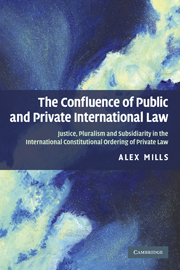 The Confluence of Public and Private International Law
The Confluence of Public and Private International Law Book contents
- Frontmatter
- Contents
- Acknowledgments
- Index of cases, judicial opinions and arbitral awards
- Abbreviations
- 1 Justice, pluralism and the international perspective
- 2 The private history of international law
- 3 From positivism to constitutionalism
- 4 Private international law and constitutional law in federal systems
- 5 The confluence of public and private international law
- 6 Conclusions
- Bibliography
- Index
5 - The confluence of public and private international law
Published online by Cambridge University Press: 20 January 2010
- Frontmatter
- Contents
- Acknowledgments
- Index of cases, judicial opinions and arbitral awards
- Abbreviations
- 1 Justice, pluralism and the international perspective
- 2 The private history of international law
- 3 From positivism to constitutionalism
- 4 Private international law and constitutional law in federal systems
- 5 The confluence of public and private international law
- 6 Conclusions
- Bibliography
- Index
Summary
Introduction
The history of public and private international law explored in Chapter 2 is a story of divergence. The traditionally broad conception of the ‘law of nations’ was fragmented into public international law, law between states, and private international law, which became understood as part of national law dealing with international private disputes, rooted in a positivist conception of state sovereignty. As examined in Chapter 1, the theoretical focus of contemporary private international law is mistakenly placed on ideas of private justice and fairness. This is the product of positivist international law theory, a set of outdated norms subject to the explanatory and normative critique explored in Chapter 3, which are no longer consistent with international law. The theory of private international law struggles to justify and explain private international law rules because it is blind to the reality that private international law ‘stems from the law of nations’, that it is ‘both within and outside the individual legal system’. Although it is formally national law, ‘sociologically, economically and in terms of international relations, private international law is the common language of private international legal association’.
The divergence between public and private international law has, however, always been greater in theory than in practice, particularly as public international law has (re-)expanded to encompass private relations. Despite the dominance of the positivist perspective, private international law rules continue to reflect and replicate underlying ideas of international order, in the context of private law – they constitute a hidden (private) international law.
- Type
- Chapter
- Information
- The Confluence of Public and Private International LawJustice, Pluralism and Subsidiarity in the International Constitutional Ordering of Private Law, pp. 211 - 297Publisher: Cambridge University PressPrint publication year: 2009


